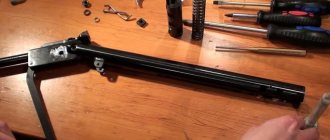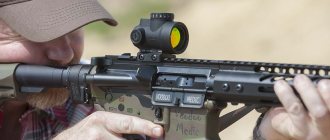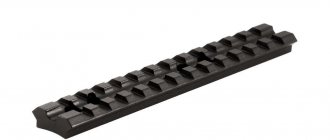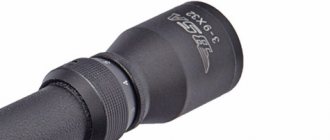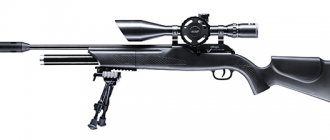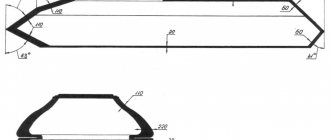- March 3, 2019
- Weapons and ammunition
- Natali Michaelis
Proper zeroing of an optical sight on an air rifle is no less important, as in the case of firearms. Good optics allow you to shoot at long distances and reveal the full internal potential of pneumatics. Such a weapon is ideal for hunting small fur-bearing animals or birds that prefer to stay away from humans. Read our article about how to zero an optic on a pneumatic rifle.
Reactivation of weapons
First of all, it is worth re-preserving the newly purchased pneumatics, since most manufacturers generously lubricate their rifles with oil, which affects the flight of the ballistic projectile. However, such an action should be carried out not only for pneumatic weapons, but also for firearms. A schematic algorithm for depreserving the air should look something like this:
- We completely disassemble the rifle;
- remove the spring-impact mechanism from the weapon;
- we almost completely get rid of factory lubricant;
- We clean all elements of the compressor system.
During work, you should use only high-quality compounds and solvents. After completing the procedure, you need to lubricate the rifle with gun oil or silicone, and then reassemble the air in the reverse order.
Preparatory activities
Before you begin the zeroing process, it is worth carrying out a number of preparatory procedures that will save not only ammunition, but also precious time. In the following sections, you will learn how to mount a scope on an air rifle, as well as what cold zeroing is and what it is used for. Follow all the recommendations, and then you will be able to configure the airborne optics as correctly as possible and in a short time.
Types of optical sights
Before you begin zeroing a rifled weapon, you will first have to select a suitable optical sight for it. It is important to understand that not all optics presented in gun stores are equally effective for hunting purposes. Typically, “body kit” is classified according to the following principles:
- Multiplicity. It can be fixed (the optics do not have the ability to zoom in and out) or adjustable (varies from 1.5x to 9x or more). Of course, the first option will cost almost 2 times less, but the second is considered universal, since it can be used at various distances.
- Line of sight. It represents the very region of space that the shooter sees in the eyepiece. This indicator is usually measured in degrees or meters. The larger the field of view, the easier it will be for the shooter to search and observe the target. So it’s better not to skimp on this parameter, especially if you plan to use the optics for hunting.
- Reticle (or reticle). An auxiliary image that the shooter uses to aim at a target. There are a huge variety of sighting reticles: cross with a dot, thin cross, German mark, duplex, circle, mild dot, PSO and so on. For hunting, it is recommended to use something simple that does not block your view.
- Diameter of the entrance lens. The characteristics of the sighting device depend on this parameter. The thicker the lens, the higher the aperture ratio and wide field of view the optics have. At the same time, this parameter greatly affects the weight of the accessory, and therefore the weight of the weapon too.
- Sight body. As a rule, optics are a monotube with several lenses. This oblong part can be made of plastic, metal or duralumin. The higher quality the material, the longer the service life the optics can boast. Plastic does not have the best tightness, and can also dry out in the sun.
Sight KONUS KONUSFIRE 3-9×32 30/30
There are many types of optical sights, so it is quite difficult to classify them. Hunting enthusiasts should opt for inexpensive pankratic models (around 6,000 rubles) with adjustable magnification from 2x to 8x and an aiming mark in the form of a thin reticle or a reticle with a dot. This “body kit” is considered universal and is suitable for hunting most types of game from a distance of 80 to 600 meters.
Installing an aiming device
First of all, you should install an optical sight on your weapon. Most self-respecting manufacturers necessarily equip their optical device with special instructions, which greatly simplifies the process of installing it on a rifle. As a rule, the entire algorithm of actions consists of fastening the optics using special devices and bolts. To do this, you don’t even need to use any tools other than a screwdriver and the wrench that comes with the kit.
The most common types of fastenings today:
- paired brackets;
- Weaver strap fastening systems;
- brackets for dovetail sighting bar;
- various hardware for attaching the optical sight to the side rail.
If you have purchased an optical device that easily attaches to your weapon, then all you need to do is install it on the sighting bar and tighten it with a few bolts. However, you should not work with a wrench and a screwdriver with great zeal, since if the thread breaks, you will have to replace the entire fastener.
Cold shooting
Have you decided to configure your airborne optics as correctly as possible? Then you will have to resort to cold zeroing - the process of adjusting the optical or open sights when not a single shot is fired. To zero in optics, the process can be done in three well-known ways.
- With the help of a fly. It is necessary to align the center point of the sight in the lens with the open front sight. Of course, this procedure can only be carried out if you have the open sight set up correctly.
- With the help of a rear sight. Similar option to the previous one. However, it is not the front sight that is used as a guide, but the rear sight. This zeroing gives less accuracy, so the bullet may go up or down a little.
- Using a laser. The most accurate cold shooting process. To implement it, you will need to buy a special laser, which is inserted into the muzzle channel of the air gun. After this, all that remains is to align the aiming bar in the lens with the red dot on the target.
After cold zeroing, the optical sight is considered practically adjusted. This process allows you to save precious ammunition, but after it it is still recommended to carry out a “hot” zeroing, at least to make sure that the weapon is working.
Preparation
The first step in zeroing an optical sight is preparing the weapon. This process should be approached with great responsibility, since the accuracy of the adjustment of the optical sight may depend on it. If even the slightest mistake is made, the bullet will fly past the target. Let's take as an example the Tiger carbine, which is quite famous among hunters.
Test shot
As a rule, a test shot does not even have to be fired at the target, because it is not carried out in order to determine the difference between the aiming point and the impact point, but in order to make sure that the weapon is working. Perhaps you have not secured the optical sight properly and will notice this after a test shot. This procedure also allows you to verify the accuracy of cold zeroing. As an impromptu target, you can use any bottle, jar or medium-sized object that you wouldn’t mind breaking.
Position selection
If the test shot does not reveal any defects, then you can begin the “hot zeroing” process, but first it is recommended to choose the right position. Of course, correct zeroing of an optical sight should be carried out indoors, but going to a shooting range in most cases is considered an unaffordable luxury, so you have to be content with an open area on a windless and clear day.
Remember that the flight of a ballistic projectile is influenced by natural factors: wind speed, air humidity, precipitation. It is also necessary to use a special weapon locking machine. In the absence of such, a dryer, a bag of sand, or any horizontal surface on which you can rest the forend will do.
You should also find a place that would allow you to gradually increase the distance to the target, because zeroing an air rifle with an optical sight is a step-by-step process. You should not be disturbed by random passers-by, even if they hear the sounds of gunfire, because this may affect their safety. And the landscape should be as flat as possible so that the shooter can take a comfortable position.
Brief conclusion on the topic
Any novice weapon user can perform zeroing. The procedure will improve the quality of shots. The location is chosen at your discretion. If it is more convenient to regulate weapons at a shooting range, then you should go there. An open area is more suitable - you should follow safety rules. Pneumatic weapons, like military weapons, can cause accidents, even death.
Is it possible to zero a rifle without an optical sight?
Yes. The procedure will be similar. July 29, 2022
Choice of ammunition and target
Of course, for airing it is best to use those bullets recommended by the manufacturer. However, most of them differ in shape. In this case, it is advisable to use as flat or rounded samples as possible to adjust the optics, since they leave more accurate marks on paper targets.
Speaking of the last one. For zeroing, it is recommended to use ordinary paper targets with sports markings applied to them (like biathletes), which are attached to a wooden surface. It is best to use the center of the target or the bottom of the circle as the aiming point, depending on the shooter's individual preferences.
Zeroing in from 25 meters
Answering the question of how to zero an optical sight on an air rifle, it is worth noting that no matter how powerful the weapon and sighting device you have, zeroing begins strictly from a distance of 20-25 meters. After several shots and appropriate adjustments, the distance is doubled and so on until the distance between the shooter and the target is 200 meters. Shooting from a distance of 200+ meters is considered sniper and is carried out only at the shooting range.
We take a comfortable position and make three consecutive shots at one point while exhaling between heartbeats. After this, we determine the average point of impact and adjust the optical sight using the key that comes with the device. After this, we repeat the procedure. Are you satisfied with the results? We change the target and increase the distance to 50 meters.
Zeroing in from 100 meters
Zeroing an optical sight on an air rifle from a distance of 50 meters is not much different from zeroing at 25 meters, so let's move on to adjusting the optics at a distance of 100 meters. The results will be acceptable only if the shooter has sufficient skills, because shooting from such a distance is not so easy. Fire three shots and watch the bullet spread. If it is no more than 7 millimeters, then you can adjust the optics and repeat the procedure until the distance between the aiming point and the impact point is minimal. If the spread turns out to be too large, then it is necessary to replace the target and take a more convenient position. In some cases, it may be that a large spread of bullets is associated with internal defects of the weapon, but this happens extremely rarely.
Evaluation of shooting results
The average point of impact (MIP) is a key parameter for assessing the zeroing of airgun optics. The meaning is easy to determine.
It is enough to do the following:
- 3 shots fired. The nearest breakdowns in the target are connected to each other by a straight line.
- A segment is obtained that is divided in half.
- Now you need to draw the beam from the central point to the third hole from the bullet (the farthest entrance).
- The resulting single beam must be divided into two equal components.
- Finally, you need to draw another line, namely, connect the two central points of the resulting segments. The third part of the distance from the first center point to the second is the STP value.
When the shooter knows the STP and has received the formed “dial,” he can easily identify the presence of deviations in alignment and make adjustments to the configuration. Shooting is a universal procedure. You can test both “capricious” optics and a red dot sight.
Precautionary measures
If you want zeroing an optical sight on an air rifle to be not only as effective as possible, but also safe, then you must follow basic rules that will help avoid injury to the shooter himself and bystanders.
- Pay attention to every rustle in the bushes, as there may be people behind them. Even experienced hunters sometimes neglect this rule, which causes accidents.
- Keep your rifle in top condition. Any weapon requires constant lubrication and cleaning, as do sighting devices. Neglecting this rule can lead to rupture of the muzzle channel during a shot.
- Use only standard ammunition and accessories. Some hunters, in order to save money on purchasing ammunition, prefer to use homemade bullets, which are of poor quality. This can also lead to damage to the weapon and serious injury to the hunter.
And be sure to remember the main rule of zeroing an optical sight on an air rifle and firearms - be sure to put the hunting tool on the safety when you go to the target to evaluate the results. Who knows what could happen while your back is turned to a loaded and ready-to-fire weapon. By the way, if you decide to set up an aerial sight without optics, then zeroing is carried out by analogy with everything described above.
Pointing an air rifle through the bore
- Targets are brought to the shooting range. They need to be placed from the rifle at a distance of 25 m or 100 m.
- The rifle is mounted on a bipod. If it is not there, any other tall and stable objects are used to fix the rifle in a stationary state while zeroing. All parts of the weapon must not be placed on hard material. You need to make sure of this before you start shooting.
- If the rifle is equipped with a sliding bolt, then before using it you need to remove it, and then align its position relative to the target, adjusting the position through the channel equipped in it.
- The bolt must be opened if a single-shot rifle is used.
- It is not possible to adjust air guns through a channel.
Aiming the sight - The rifle is positioned in such a way that when looking through the breech, the target is in the center of the hole, although it is 100 m from the weapon.
- The crosshair of the sight is set with visibility on the same target , while the remaining parts of the weapon cannot be moved.
- If all parameters match, the rifle becomes zeroed.
